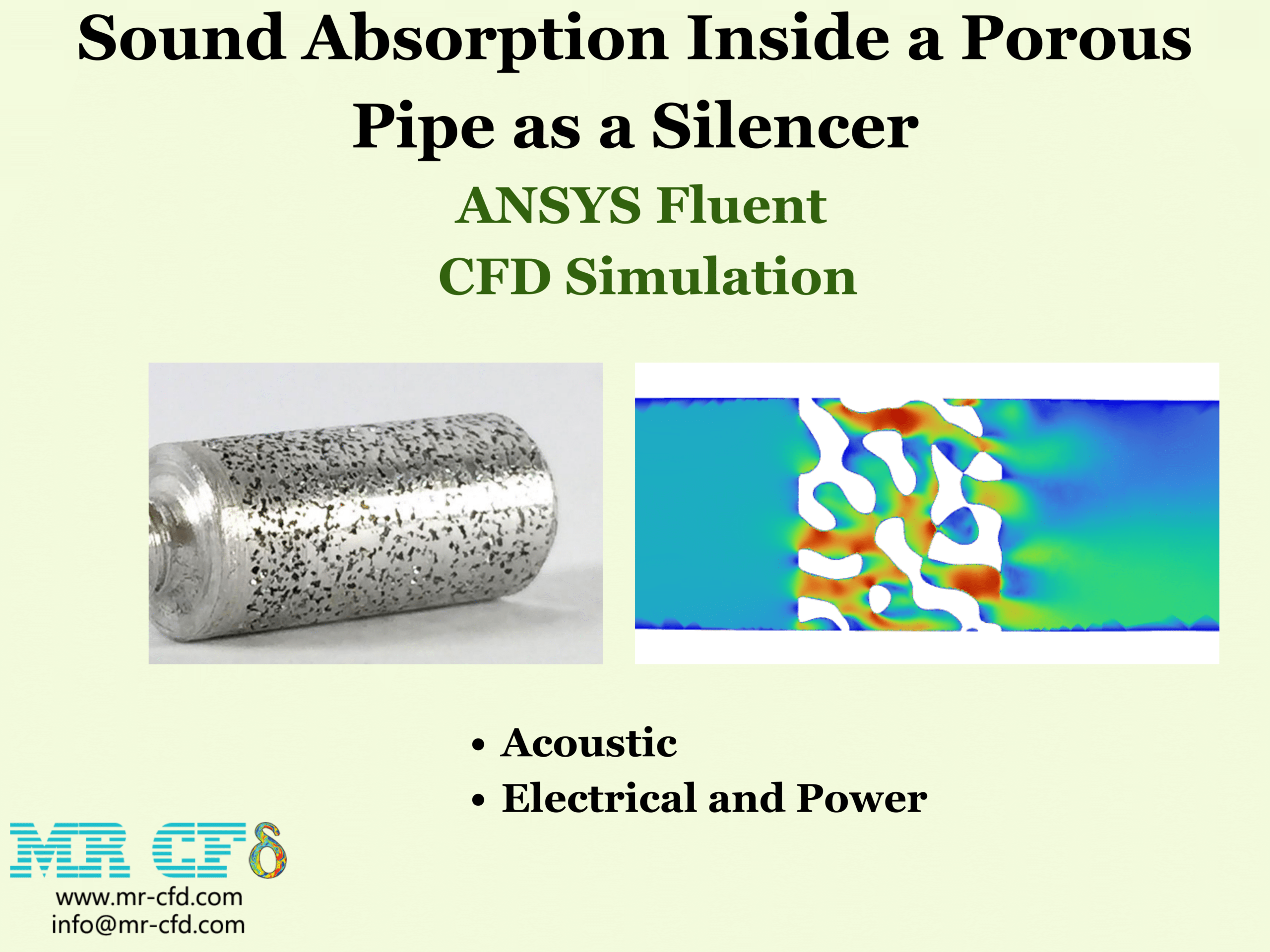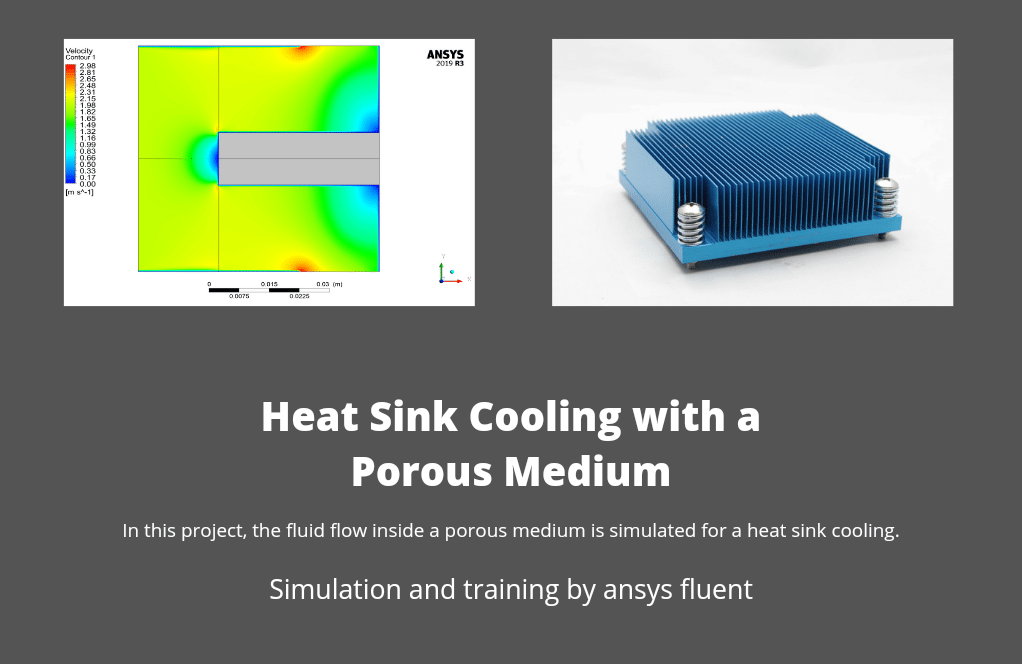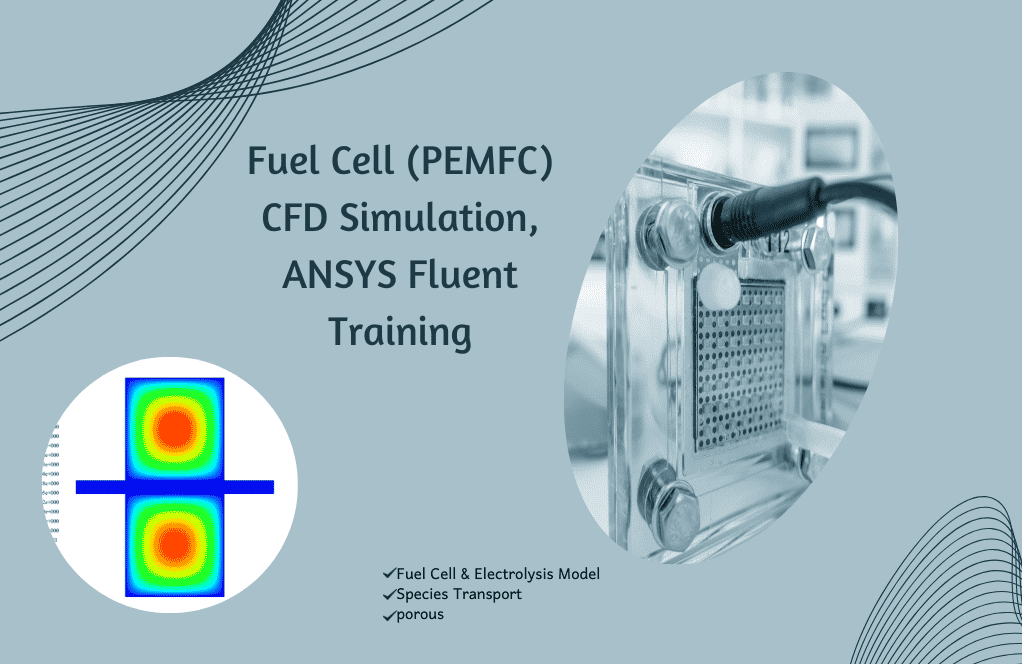Sound Absorption Inside a Porous Pipe as a silencer, ANSYS Fluent
$120.00 $60.00 Student Discount
- The present problem simulates the Sound Absorption Inside a Porous Pipe as a silencer using ANSYS Fluent.
- We have designed the 3-D geometry using SpaceClaim software and created 1,209,174 polyhedral cells on this geometry using ANSYS Meshing software.
- We employ the FW-H acoustic model to predict the acoustical behavior of systems.
To Order Your Project or benefit from a CFD consultation, contact our experts via email (info@mr-cfd.com), online support tab, or WhatsApp at +44 7443 197273.
There are some Free Products to check our service quality.
If you want the training video in another language instead of English, ask it via info@mr-cfd.com after you buy the product.
Description
Description
The implementation of porous mediums within tubular structures has emerged as a pivotal strategy for sound absorption. This technique exploits the inherent properties of porous materials to dissipate sound energy, thereby mitigating noise pollution and enhancing the auditory experience within the confines of the tube.
In this problem, we aim to simulate the phenomenon of sound absorption inside a pipe using a porous medium as silencer. Thus, it plays a roll of a silencer. The primary objective of our study is to measure two key parameters over a wide range of frequencies:
Transmission Loss (TL): It represents the loss of sound power when sound travels through the pipe filled with a porous medium. It’s a crucial factor in many engineering applications where sound reduction is desired.
Sound Pressure Level (SPL): It is the pressure deviation from the ambient atmospheric pressure caused by a sound wave. In our context, we are interested in understanding how the SPL changes over a wide range of frequencies when the sound propagates through the porous medium inside the pipe.
The geometry of the model is designed in ANSYS SpaceClaim software. Next, the computational domain is divided into separate cell zones in ANSYS Meshing software. Thus, 1,209,174 polyhedral cells are generated.
Methodology
To accomplish this, we are employing the FW-H acoustic model. This model is well-regarded for its ability to accurately predict the acoustical behavior of systems, making it a suitable choice for our simulation. Through our study, we hope to gain a deeper understanding of how sound behaves in these conditions, which could have significant implications for various fields, such as acoustical engineering, environmental noise control, and more.
The inlet and outlet are placed 200mm and 500mm far away from the silencer, respectively. The air enters the tube with a 5m/s velocity magnitude. It should be noted that the flow equations are solved in steady-state form. Then, the acoustic equations are also added and continued unsteadily.
Conclusion
As the air enters the pipe, it needs to penetrate through the porous medium which results in a remarkable pressure drop due to the complex porous shape. Indeed, a stagnation point forms on the porous wall and the velocity increases dramatically, based on the Bernoulli equation. Both can be seen in the figures below.
From an acoustic perspective, the same thing is happening. In order to fulfill our objectives, 3 receivers are implemented. One of them is placed before the porous medium, 100mm away from it. The two others are placed after with 200mm and 400mm distance from the porous silencer. Before investigating the results, keep in mind that the reference acoustic pressure is set to 2e-5 Pa. Thus, all the reported values are relative regarding the reference pressure level.












Dr. Hermann Crona –
The project details mention ‘polyhedral cells’ when discussing mesh. Could you clarify what role do polyhedral cells play in the meshing process, and how do they compared to other cell types in CFD simulations?
MR CFD Support –
Polyhedral cells are used in the meshing process of CFD simulations due to their efficient and enhanced numerical qualities. They generally provide better convergence rates and require fewer cells to capture complex geometries compared to more traditional tetrahedral or hexahedral cells. As a result, they can potentially provide more accurate results with less computational cost.
Albin Wolf –
What are the specifications of the porous medium used in the simulation?
MR CFD Support –
In the simulation, the porous medium within the pipe has specific properties tailored for sound absorption. While the exact material details are not given, it’s designed with geometric and material characteristics that allow for effective dissipation of sound energy, causing Transmission Loss (TL) and reduction in Sound Pressure Level (SPL) across a broad range of frequencies.
Grace Rosenbaum –
This learning product was incredible in demonstrating the effectiveness of a porous pipe as a silencer! I wouldn’t have understood the intricacies of sound absorption and transmission loss without this clear and detailed simulation. The visuals were particularly helpful in illustrating the principles at work. Super impressed by how sound can be managed in such innovative ways.
MR CFD Support –
Thank you so much for your positive feedback! We’re thrilled to hear that you found our simulation on sound absorption inside a porous pipe as a silencer to be so helpful and informative. It’s always great to know that our visuals and explanations are making complex topics clearer and more understandable. We appreciate your interest in our learning products and are grateful for customers like you who encourage us to keep delivering quality simulations!
Nicole Rohan –
Does the software provide recommendations on the type of porous material to use for optimal sound absorption, or is that determined separately?
MR CFD Support –
ANSYS Fluent itself does not provide recommendations on the type of porous material. Typically, the selection of a porous material is based on empirical data and the specific requirements of a project. However, the simulation outputs, such as Transmission Loss and Sound Pressure Levels, can help assess the efficacy of selected materials and make engineering decisions accordingly.
Waldo Langworth –
I found the approach to noise reduction quite impressive, especially using the FW-H acoustic model within the simulation. I am curious about the effects of different porous materials on sound absorption qualities. Do you have any examples or additional studies on how sound absorption varies with different materials?
MR CFD Support –
In our studies of porous media for sound absorption, we’d typically review varying physical properties such as the porosity, flow resistivity, and tortuosity of different materials. Although specific examples haven’t been referenced here, the method of FW-H acoustic modeling applied in our simulation is capable of capturing these effects well. The variations in transmission loss and sound pressure level due to changes in porous medium can be quite different and warrant detailed studies for each material type. If you’re interested in obtaining simulation outcomes for particular materials, we can certainly assist with those specialized analyses.
Miss Annamae Nader –
I’m impressed with how the implementation of a porous medium in a pipe can serve as a sound silencer. How does the porous medium actually reduce the noise? Does it absorb specific sound frequencies more effectively than others?
MR CFD Support –
Thank you for your positive feedback! The porous medium reduces noise by dissipating sound energy through viscous and thermal losses as sound waves travel through the complex network of pores. Yes, the effectiveness in absorbing sound varies across frequencies; porous materials generally absorb higher frequencies better due to their smaller wavelengths that can be trapped and dissipated within the pores more easily. Lower frequencies with longer wavelengths are less affected by the smaller pore dimensions. Our simulations strive to identify exactly how these different frequencies are absorbed and the overall efficiency of the porous silencer across a broad spectrum.
Prof. Nickolas Little –
I’m quite impressed with the sound absorption simulation using porous materials inside the pipe. The results must be beneficial for designing quieter systems. Can you tell me more about how the FW-H acoustic model enhances the prediction of acoustic behavior in this context?
MR CFD Support –
Thanks for your kind words! The FW-H acoustic model is recognized for its accuracy in predicting the sound fields around complex geometries with porous media. It accounts for several effects including scattering, diffraction, and absorption of sound by the porous material which is crucial in analyzing the effectiveness of silencers. In the context of this simulation, it enables us to understand the detailed acoustic performance by capturing how sound pressure levels are reduced as sound passes through the porous silencer, making it an integral tool for predicting and improving sound absorption in silencer designs.
Dr. Forrest Lynch –
What exactly is the FW-H acoustic model, and how does it contribute towards the study in this simulation?
MR CFD Support –
The Ffowcs Williams-Hawkings (FW-H) acoustic model is a powerful analytical tool used for predicting noise generated by turbulent flows and aerodynamic sources. In this context, the model applies to study sound propagation and absorption within the porous pipe silencer. It helps simulate the effect of the porous medium on noise reduction and predict results like the Transmission Loss and Sound Pressure Level in the system.
Flavio Kohler –
Excellent learning tool for understanding acoustics within pipes filled with porous materials. Really appreciated the detailed methodology and how the simulation provides insights into sound attenuation via the porous silencer mechanism. The transmission loss and sound pressure level assessments over various frequencies offer significant practical benefits for acoustic engineering applications.
MR CFD Support –
Thank you for your kind words! We are glad to know that our simulation has served as a valuable learning tool and that the details offered are insightful for your understanding of acoustics and noise control applications. If you have any follow-up questions or need further insights into the simulation process, please don’t hesitate to reach out.
Miss Icie Hirthe DVM –
Absolutely thrilled with the detail and thoroughness of the porous pipe sound absorption simulation! The complex interactions between air flow and porous structure leading to sound attenuation are so well captured. Kudos to the MR CFD team for this impressive analysis – it’s a real asset for those involved in acoustics and environmental noise management.
MR CFD Support –
Thank you so much for your kind words and for acknowledging the hard work put into the sound absorption simulation using a porous medium. We are delighted to hear that you found the analysis comprehensive and useful for applications in acoustics and noise reduction. Your feedback is greatly appreciated, and it motivates us to continue delivering high-quality CFD simulations. If there’s anything else we can do for you, please let us know!
Judd Schaefer –
The presentation is detailed and informative. The use of an FW-H acoustic model and receiver placement to accurately assess the Sound Pressure Level (SPL) and Transmission Loss (TL) is impressive. Real-world applicability in acoustical engineering and noise control is clear, and graphically illustrating the stagnation point and increased velocity provides a comprehensive understanding of the physics involved. Superb utilization of porous materials as a means for noise reduction!
MR CFD Support –
Thank you for your positive feedback! We’re delighted to hear that the detailed approach and the use of the FW-H acoustic model met your expectations. It’s fantastic that you recognize the applicability of the study in fields like acoustical engineering and environmental noise control. If you have any further questions or need deeper insights into our simulations, feel free to reach out. We’re here to help!
Mr. Rhiannon Batz –
I’m really impressed with how the porous medium in the pipe performs as a silencer! Have you noticed any specific frequency range where the Transmission Loss is maximized using this method?
MR CFD Support –
Thank you for your positive feedback! Yes, in simulations such as this one, the Transmission Loss tends to be maximized at specific frequency ranges, depending on the characteristics of the porous material and the geometry of the system. The numerical study explores these dependencies and typically identifies the frequency range yielding the highest transmission loss, which is crucial for efficient sound attenuation and the design of effective silencers.